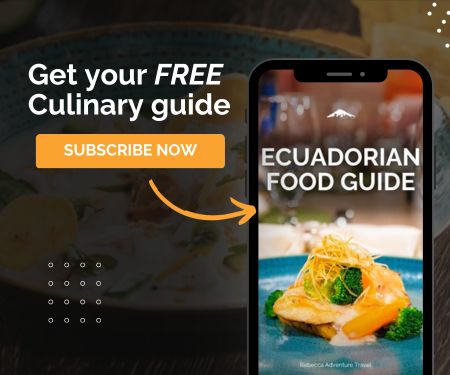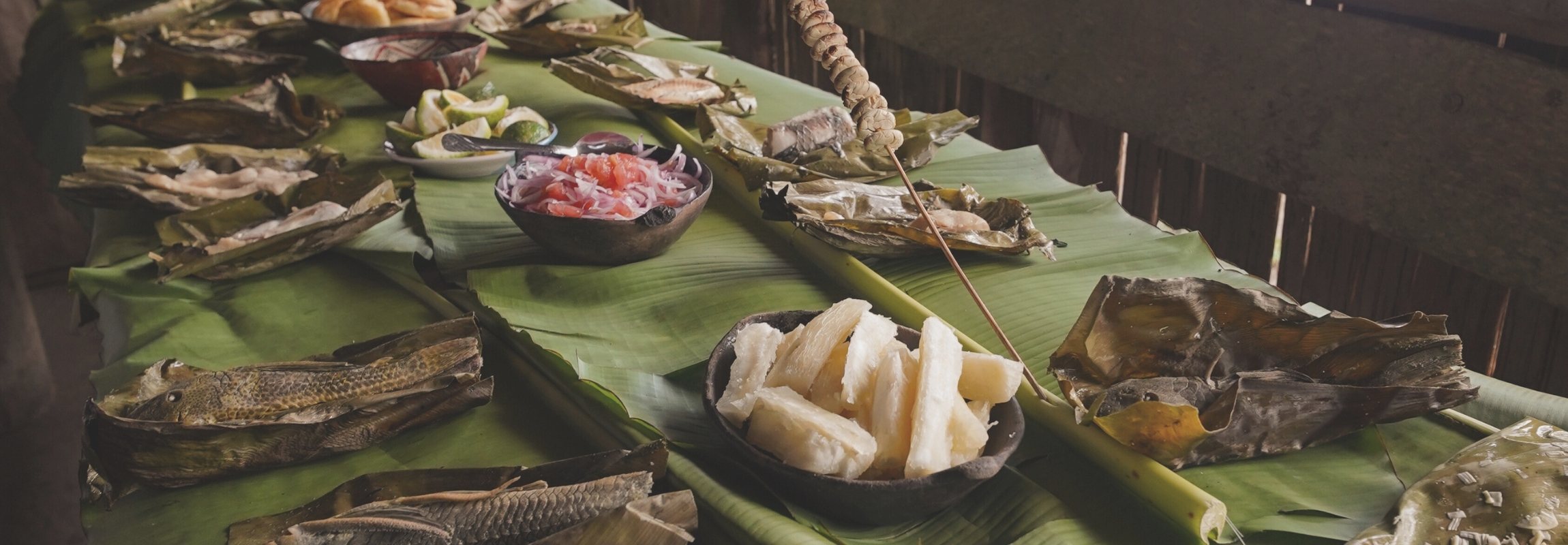
Culinary
A culinary experience is a way to explore a new destination by letting your senses be the key players. Moreover, the best thing about a culinary experience is that anyone can enjoy the trip.
Nowadays, food tourism is an innovative option for different travelers’ needs. Moreover, there are various ways to explore a gastronomic tour. For instance, some tourists enjoy taking cooking classes, while others prefer to eat at local markets and meet new friends while tasting traditional food.
What is a culinary experience?
For many travelers, the best thing about traveling is to have a culinary experience. People enjoy exploring a destination through its gastronomic offer. Likewise, you can taste the world and, at the same time, learn about a country’s culture.
According to the World Food Travel Association, “food tourism is an act of traveling for a taste of a place in order to get a sense of place”. Even so, food tours give a purpose to local producers while attracting sustainable tourists.
Top 5 Best Culinary Tours
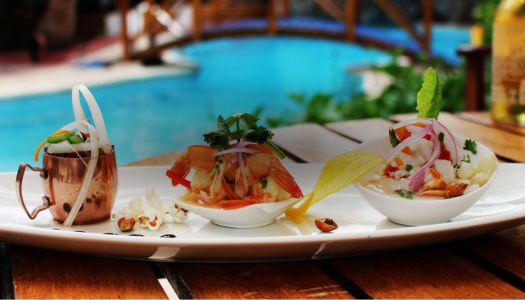
7-Day Galapagos Food Tour
The enchanted islands are not only known because of their incredible wildlife but also because of their incredible seafood. If you’re a foodie by nature, you’ll love this culinary experience.
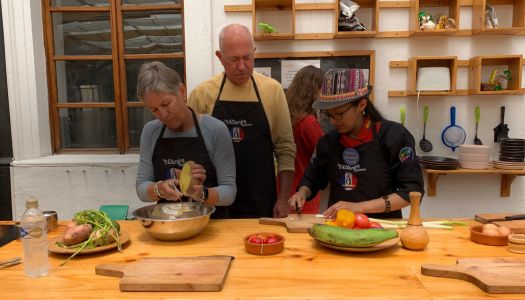
Quito Cooking Class
Quito Cooking Class is a half-day tour that takes you to the local food market in the Historic Center of Quito for an intense culinary experience.
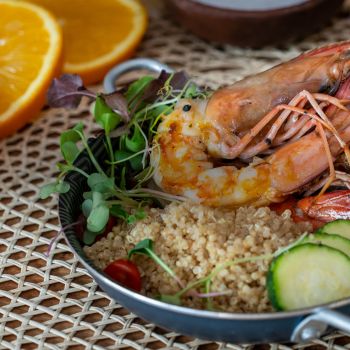
9-Day Ecuador Food Private Tour
Ecuador by having 4 different regions has a wide variety of food. If you’re a foodie by nature, you’ll love this experience. Starting in Quito with a cup of amazing coffee, quick meals in the Historical Center of Quito, and other interesting stops in the city.
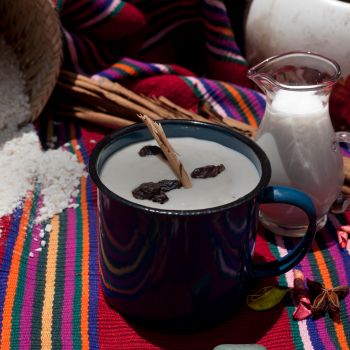


Quito Culinary Day
Quito, being the capital of Ecuador has an incredible range and variety of food. If you’re a foodie by nature, you’ll love this experience. Taste some of the typical Andean flavors with a good craft beer and other typical beverages.
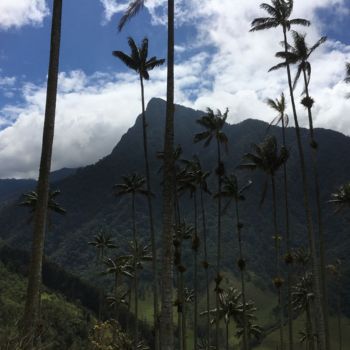

4-Day Colombia Authentic Coffee
Experience the authentic Colombian coffee region while staying in a beautiful Boutique Hotel. Discover Salamina, San Felix, and Valle de Samaria which are beautiful destinations and still undiscovered.
Why should you book a culinary trip?
A food tour is an opportunity to combine travel with the gastronomy of a destination. A culinary experience lets tourists explore endless tastes either through fine dining, street food, or traditional choices.
Regardless of the place, you’ll be able to enjoy new colors, textures, aromas, and tastes. Therefore, your travel memory can comprise a new flavor and aroma. Also, when you book a food tour with Rebecca Adventure Travel, you will get involved with spectacular places where you can feel you’re escaping from your routine and getting into an amazing adventure.
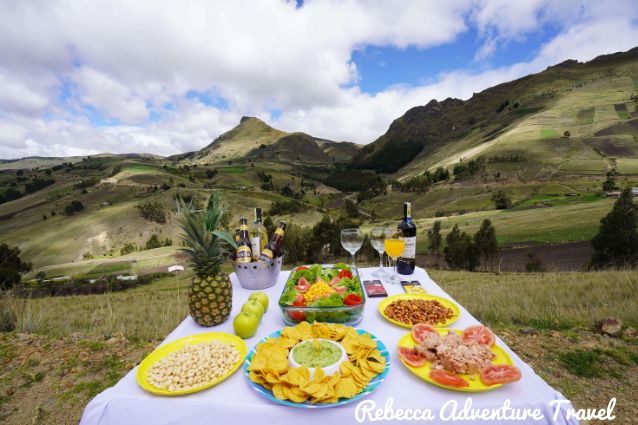

Picnic in the Ecuadorian Andes
Besides learning about a new culture, the main reasons for taking a food tour are:
- A good introduction to a destination.
- Explore every region’s gastronomy.
- Visit places frequented only by locals.
- Explore the gourmet routes in a beautiful country.
- Eat like a local.
Rebecca’s Top Picks
Rebecca, the founder of Rebecca Adventure Travel, loves to travel. She’s always planning her next trip. She enjoys discovering new places with her family. When it comes to culinary experiences, Rebecca prefers an immersive experience, discovering traditional flavors and local ingredients. Check Rebecca’s top culinary tours:
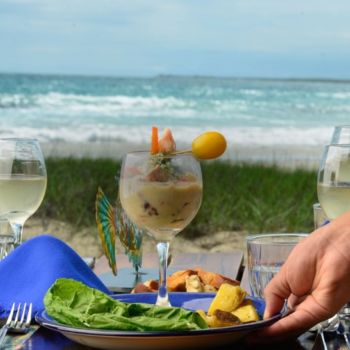

7-Day Galapagos Food Tour
The enchanted islands are not only known because of their incredible wildlife but also because of their incredible seafood. If you’re a foodie by nature, you’ll love this culinary experience.



9-Day Ecuador Food Private Tour
Ecuador by having 4 different regions has a wide variety of food. If you’re a foodie by nature, you’ll love this experience. Starting in Quito with a cup of amazing coffee, quick meals in the Historical Center of Quito, and other interesting stops in the city.



Quito Culinary Day
Quito, being the capital of Ecuador has an incredible range and variety of food. If you’re a foodie by nature, you’ll love this experience. Taste some of the typical Andean flavors with a good craft beer and other typical beverages.
When booking a culinary experience, choose a sustainable tour company
Rebecca Adventure Travel is a sustainable tour company that contributes to responsible tourism. The founder of Rebecca Adventure Travel, Rebecca Braak has the objective to take action on making tourism more sustainable. The principal objective is to contribute directly to local businesses, therefore making communities’ lives better.
Support local communities
Rebecca Adventure Travel supports local economies in Ecuador, Colombia, and Peru by offering sustainable travel destinations. When tourism supports local communities, the resources stay in the destination. Therefore, the ecosystem benefits from the industry, making it a multiplier effect.
Tour operators must back local production, in order to help lower CO2 emissions, support the creation of rural jobs, and preserve each community’s culture and heritage. When Rebecca Adventure Travel plans its food tours, the community is a priority:
- Hire local suppliers such as guides, transportation, and food vendors.
- Book with locally owned accommodations.
- Work directly with local communities.
- Provide tourists with local souvenirs.
- Use local products.
- Create slow-food menus with local chefs.
- Develop farm-to-table experiences with local communities.
- Donate and volunteer on community projects.
Check our Community Adventure Tours
What are the best culinary experiences?
Food is a global language. When you take a culinary trip to an exotic country like Ecuador, you’ll be able to improve your language skills. Moreover, you’ll learn about its culture through all your senses – especially taste and smell.
Did you know that 53% of leisure travelers are food travelers? According to the 2020 Food Travel Monitor, the industry is highly influenced by food tourism. Even so, food represents 25% of the economic benefit to a destination. However, sustainability is key. 63% of millennials seek socially responsible tour operators when they book a culinary experience.
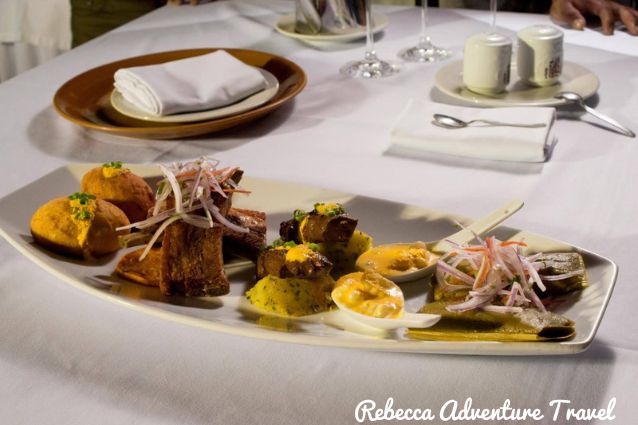

Ecuadorian Gastronomy
Therefore, the best culinary trips for adventurous travelers are the ones that make a memorable experience for the guests.
17-Day Luxury Ecuador & Galapagos
9-Day Ecuador Food Private Tour
11-Day Hidden Treasure Ecuador
Discover Ecuador through its traditional food
Ecuador has a very diverse local cuisine. The country’s gastronomy is as varied as its four regions: the Andes, Amazon, Coast, and the Galapagos Islands. Each region has its own distinct cuisine thanks to the diversity of the agricultural products.
In general, Ecuadorian dishes have locally-produced ingredients. Ecuadorians love to share their delicious and flavorful dishes. The majority of menus might include:
- Meat, chicken, pork, and seafood
- Green plantain
- Fruits and vegetables
- Grains
- Rice and potatoes
Moreover, Ecuador has soups, main dishes, and desserts. Flavors are unique and incomparable. If you want to learn more about the best food in Ecuador, check out Rebecca Adventure Travel’s Ecuadorian Food Guide.


Ecuadorian Traditional Dish
Traveling is an experience, where you’ll discover new places, and flavors and meet new people. And a food tour is the perfect way to do so! It is a guided experience created with the objective of introducing tourists to the history and traditions of a new culture. It mixes history, context, and flavors, becoming a means to explore a destination.
Traditional sweets
As with any other South American country, Ecuadorian traditional sweets and desserts are a treat for tourists. Traditional pastries and bakeries are very easy to spot because of the amazing smell! Therefore, when you visit Ecuador, remember to make a list of sweets and desserts for your culinary experience, and try:
- Espumilla (Sugar Mousse).
- Dulce de higos (Sweet Figs with Cheese).
- Tres leches (Milk Sponge Cake).
- Garrapiñada (Caramel-coated peanuts).
- Pristiños (Fried pastries served with raw sugar syrup).
- Arroz con leche (Rice with milk).
- Melcocha (Sugarcane Candy).
- Huevos mollos (Creamy Candy Eggs).
- Helado de paila (Paella Ice Cream).
- Cocadas (Coconut Balls).
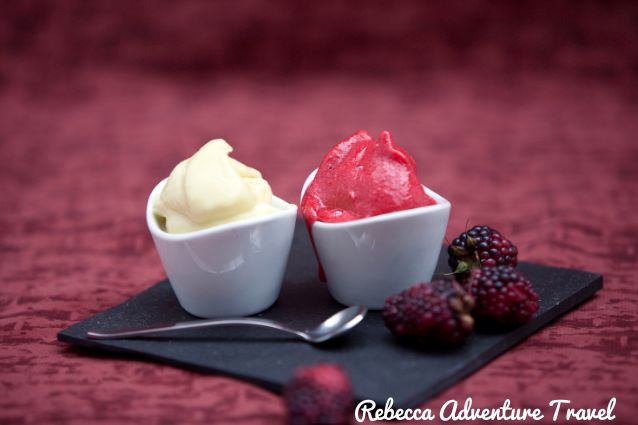

Helado de paila (Paella Ice Cream)
Experience the pamba mesa
Pamba mesa is a communal meal that is laid on a cloth spread on the ground. It’s organized as an act of social solidarity, used at festivals, family reunions, and mingas (collective work).
Traditionally, every participant brings the food they want to share. Further, it’s common to eat with your hands. Additionally, the community leader will give thanks for the food and offer some to Mother Earth.
Moreover, in the pamba mesa you can find traditional Ecuadorian ingredients such as:
- Mote (Boiled Corn Kernels).
- Potatoes.
- Quinoa.
- Carrots.
- Sweet potatoes.
- Fava beans.
The Pamba Mesa is an amazing experience because you really have the opportunity to share with the local community. Are you in Quito and would you like to experience the Pamba Mesa prepared by an excellent local chef? Go to “Quitu” restaurant where chef Juan Perez prepares the best gourmet Pamba Mesa for you.
Try the Ecuadorian chicha drink
In terms of beverages, at a pamba mesa, you’ll find chicha de jora, a fermented alcoholic beverage, and chicha morada, the non-alcoholic version.
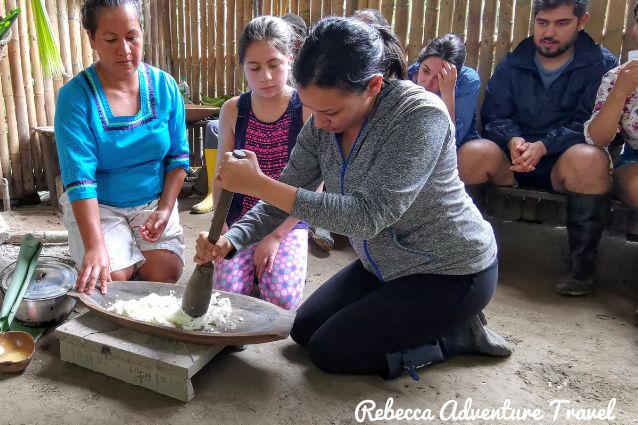

Preparation of Ecuadorian chicha drink
Chicha is a native drink to Latin America that has its roots in the pre-Columbian period. It’s a corn-based beer, made from maize. Also, chicha has religious importance in ceremonies and festivals. It’s a white-yellow liquid, with a milk consistency and a sour aftertaste.
Street food
Street food is one of the best ways to learn about a country. For instance, a popular food in Ecuador is widely available for adventurous travelers. You can find delicious street food in local fairs, festivals, markets, main plazas, bus stops, and beach towns, among others.
If you’re up for trying Ecuadorian food in a different way, street food is the best option for you. You can find both sweet and savory food everywhere you go. The best way to enjoy street food in Ecuador is to book a tour with Rebecca Adventure Travel. That way you’ll taste traditional popular dishes in markets and local fairs:
- Hornado (Slow roasted pork).
- Fritada (Braised pork).
- Encebollado (Fish stew).
- Empanadas de viento (Fluffy fried cheese empanadas).
- Empanadas de morocho (Corn dough stuffed with cheese and meat).
- Empanadas de verde (Green plantain dough with cheese, shrimp, meat, or meat filling).
- Pinchos (Beef skewers).
- Chochos, chifles and tostado (Lupini beans, green plantain chips, and Andean corn nuts).
- Tripa mishki (Cow intestines).
- Guatita (Cow stomach stew).
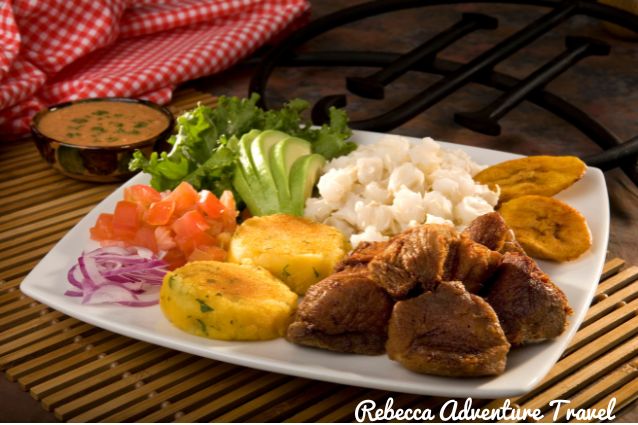

Fritada (Braised pork).
Cooking classes
Cooking classes are a great way to immerse yourself in a new culture. A culinary experience is complete when you are able to expand your knowledge of a country based on the food you taste! Here are 5 reasons why you should book a cooking class on your next trip:
- Learn about the culture.
- Enjoy a fantastic meal.
- Experience local markets.
- Interact with locals.
- Meet other travelers.
- Cook your favorite meal with Ecuadorian ingredients.
Drinks and cocktails
Beverages are an essential part of any type of food tour. A culinary experience must include drinks. Further, food tourists enjoy alcoholic beverages as well as non-alcoholic drinks. A food tour can have soft drinks, mineral waters, fresh juices, tea, and coffee.
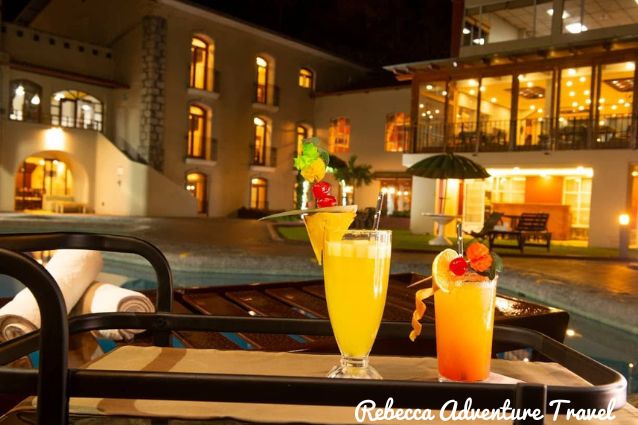

Drinks and cocktails
Ecuadorian festivities are perfect for new culinary experiences
Ecuadorians are happy, lively, and festive people. In general, citizens have a positive attitude towards tourists and world travelers.
Throughout the year, there are several holidays and festivities that show the cultural traditions of Ecuador, where tourists can enjoy an amazing culinary experience. The major holidays are sprinkled with colorful traditions and delicious local food.
Carnival
Carnival is the Ecuadorian equivalent of the United State’s Mardi Gras. The festival’s date differs from year to year. However, it’s usually celebrated in February or early March, 40 days before Easter and prior to the Catholic fasting period (mid-February). It’s a very playful festivity. Moreover, it’s an excellent way to enjoy Ecuadorian street food.
Ecuadorians love to tease others by throwing flowers, water, and flour at friends, family, and even unknown people on the streets. In recent years, people like to spray foam at each other. If you’re in Ecuador during carnival season, you can buy spray foam on the streets and be part of the party!
Semana Santa (Holy Week)
Semana Santa, or Holy Week, is a celebration with a mixture of indigenous traditions and Catholic beliefs. The most famous dish during Holy Week is called fanesca.
Fanesca
Fanesca is a very elaborate Lenten soup. It’s a stew that combines 12 grains and dried cod in a creamy base. Additionally, people like to add peanuts, hard-boiled eggs, fried plantains, squash, avocado, and empanadas.
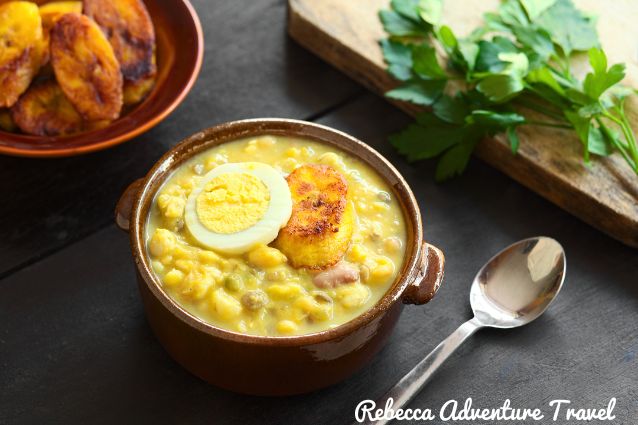

The grains are divided into beans and vegetables. Did you know that they represent Jesus’ 12 apostles, while cod represents Jesus? Every Good Friday (the date when Christians commemorate Jesus’s crucifixion), families congregate and eat fanesca for lunch. This dish is so delicious and complete that it may be the only thing you eat the whole day!
Inti Raymi (Sun Festival)
The Inti Raymi, or Sun Festival, is a celebration of gratitude towards the sun. This Andean tradition starts at the end of June and goes to the beginning of July, with the sunset of the longest night of the year. The celebration matches the harvest season and the end of the agricultural cycle.
This festivity is a joyful event that symbolizes new beginnings. That’s why indigenous communities like to give thanks to the Incan sun god, also known as Taita Inti (Father Sun in Quechua).
Indigenous communities like to celebrate by dancing, drinking, and eating. The food is served in a Pamba Mesa style, on a tablecloth that lies on the ground. It includes beans, corn, potatoes, and guinea pig. Also, chicha is drunk. Moreover, indigenous rituals include tributes offered to the Pachamama (Mother Earth).
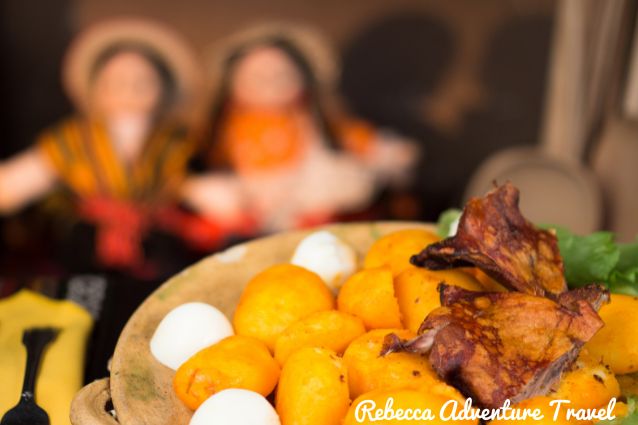

Gourmet Cuy
The Festival of La Mama Negra
The Festival of La Mama Negra (Black Mother) is a culturally vibrant and mixed event of indigenous, Spanish, and Spanish influences. It takes place in September and November in Latacunga, the capital city of Cotopaxi province. It started as a grateful commemoration of 1742 when the Virgin of Mercy (Virgen de la Merced) allegedly stopped the eruption of the Cotopaxi Volcano.
Citizens and tourists fill the streets to watch a parade with legendary characters. Dancers, musicians, and bands gather for the theatrical celebration, while la Mama Negra rides a horse.
La Mama Negra is a mix of the Virgin Mary and African deities. The character has an elaborate costume bearing dolls that represent her children. Also, she sprays milk and water on the spectators.
While the crowds enjoy the parade, they can find delicious and traditional Ecuadorian street food such as chugchucaras. Chugchucaras is an elaborate dish that has:
- Mote (boiled corn).
- Fritada (fried pork).
- Aji (chili sauce).
- Empanadas (sweet, cheese-filled pastries).
- Potatoes baked in oil.
- Fried sweet plantain.
- Popcorn with toasted corn.
- Cuero (fried pork skin).
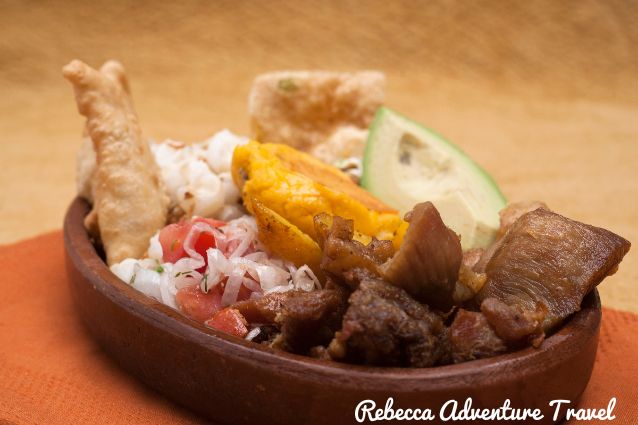

Chugchucaras
Day of the Dead (Día de los Difuntos)
As a Latin American country, the Day of the Dead is a very important festivity in Ecuador. Moreover, the Day of the Dead, also known as the Day of the Dead or All Souls Day, is celebrated on November 1st and 2nd. This celebration focuses on remembering loved ones that have passed and eating delicious food.
Every year, families gather together to prepare and eat guaguas de pan (translates literally as bread babies –are sweet bread shaped into doll-like figures) and colada morada (spiced berry drink).
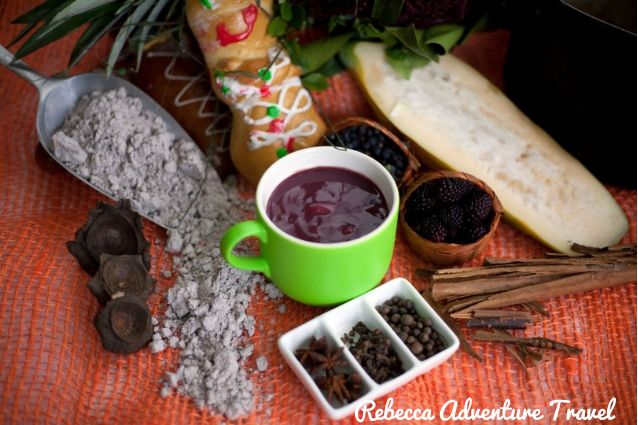

Traditional guaguas de pan and colada morada
In Ecuador, the Day of the Dead is a two-day national holiday. Families visit cemeteries to pay their respects to loved ones who passed away. They bring flowers and food to share. Traditionally, families make a picnic over the tops of the graves, placing the foods that the deceased loved ones liked when they were alive.
Enjoy the experience of eating traditional Day of the Dead food
The colada morada and guaguas de pan tradition dates back to the pre-Incan times. Indigenous people will gather together to celebrate the rainy season between October and November.
Colada morada
For these cultures, the rain was a bearer of life. Therefore, they celebrated the journey to the afterlife. Their celebrations included a purple-corn beverage that resembled blood, and Andean blueberries and blackberries as well as fruits. You can find the best Colada Morada in Quito. There is a local bakery called Cyrano where you can enjoy the best Colada Morada & Guaguas de Pan (add this link https://www.cyrano.com.ec/). Note: this is only available during October.
Guaguas de pan
On the other hand, the guaguas de pan are, in fact, a representation of a person. In quichua, guagua means kid. After the Spanish colonization and the establishment of Catholicism, indigenous communities started baking bread in the shape of the deceased as a way of remembering them while they visited their graves.
Guaguas de pan are sweet pastries filled with jam, caramel, or chocolate. They have different decorations and are served with a cup of colada morada. The beverage is made with cornflour, sugar, spices, and blueberry, blackberry, and pineapple rind.
New Year’s Eve
New Year’s Eve in Ecuador is an explosive experience for tourists. For instance, citizens like to celebrate following a weird tradition of recreating the viuda character, or “widow of the old year.” Across the country, men dress up in high heels, short skirts, and female wigs. They dance in the streets. Even so, they ask for money because they “need to pay” for the viejo’s funeral.
The viejo is a cardboard doll that lays close to his viuda. Generally, they represent politicians or popular personalities, like superheroes or cartoon characters. The dolls are burned at midnight. Ecuadorians like to jump over burning dolls while letting go of the bad moments from the previous year, and look forward to the New Year positively.
Eating twelve grapes
Ecuadorians are very close to their families and friends. Commonly, New Year is a family-friendly festivity, where families gather together and enjoy following customs. Further, one of the most important New Year’s practices is to eat 12 grapes. As a Catholic country, the grapes represent the 12 apostles, as well as the months of the year.


Twelve grapes tradition
The grapes must be eaten in the first minute of the new year! Ecuadorians like to think that they will have good luck. You can enjoy New Year’s in the Ecuadorian way by booking a tour around Ecuador’s Mainland and the Galapagos Islands.
Inspired by Ecuadorian festivities? Book a tour!
Discover Ecuador through a culinary experience
Food tourism in Ecuador is an out-of-the-ordinary culinary experience. You can taste and flavor Ecuadorian cuisine in many ways. Every dish is characterized by native ingredients.
Ecuador is a land of contrasts: starting on the mountains and moors, then you can travel directly to the ocean or the jungle. This closeness gives you the opportunity to delight in typical dishes as well as mind-blowing landscapes.
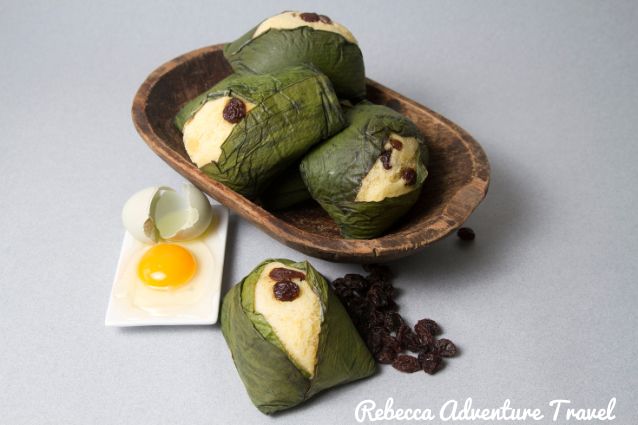

Ecuadorian Andes typical dish
Best food from the highlands region
Soups are one of the best well-kept secrets of Andean cuisine. However, the highlands region also has main dishes and desserts. In most of the traditional plates, you’ll find pork, beef, and chicken, combined with potatoes, rice, corn, and grains. Then, what are the best Andean dishes?
- Mote pillo (Sautéed hominy).
- Locro de papa (Potato stew).
- Llapingachos (Fried potato pancakes).
- Churrasco (Ecuadorian grilled meat).
- Quimbolitos (Sweet steamed cakes).
The Coast and the Galapagos Islands have fresh seafood
Seafood is delicious and very fresh in Ecuador. In the coastal region, tourists can find dishes prepared with coconut, green plantain, peanuts, as well as fruits and vegetables. Traditional dishes are:
- Bolón de verde (Green plantain dumplings).
- Encebollado (Fish stew).
- Encocado de pescado (Fish with coconut sauce).
- Fried yuca (Cassava fries).
- Patacones (Fried plantain).
14-Day Andes, Amazon & Coast Adventure
7-Day Galapagos Food Tour – Small Group
15-Day Luxury Ecuador & Galapagos Highlights
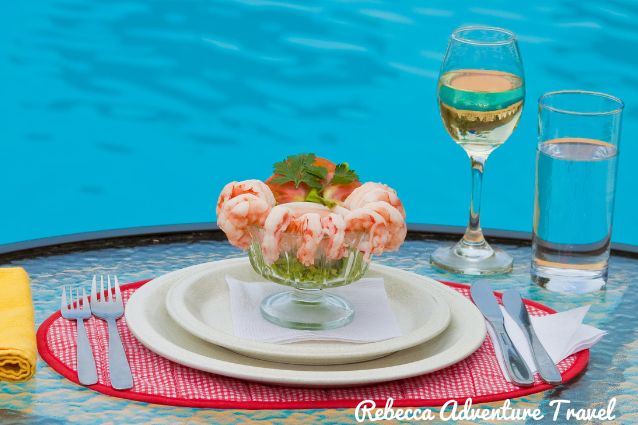

Seafood is delicious and very fresh in Ecuador.
The Amazon is a cultural region filled with culinary experiences and adventure seekers
Most people visit the Amazon for its lush vegetation and wildlife observation. However, the region also has a vast cultural diversity. Its traditional dishes are:
- Maito (Fish filet).
- Chontaduro (Chonta worm).
- Manioc tamal (Yucca bread).
- Ceviche de palmito (Heart of palm ceviche).
- Guayusa tea.
4-Day Amazon Cuyabeno Adventure
6-Day Amazon Cuyabeno & Papallacta Adventure


Maito (Fish filet).
If you decide to embark on a culinary adventure, you are almost guaranteed to learn through new flavors and ways of eating! A culinary trip, or food tourism, is an activity that offers tourists an opportunity to appreciate a new destination’s history, culture, and environment. Are you ready to book yours?
Build your own trip
If you want to book a culinary experience, you can contact us to create your customized trip. If you have special requests like a complete private tour with services and hotels chartered, a honeymoon, a family trip, or a very short tour, our Destination Experts will be happy to help.



